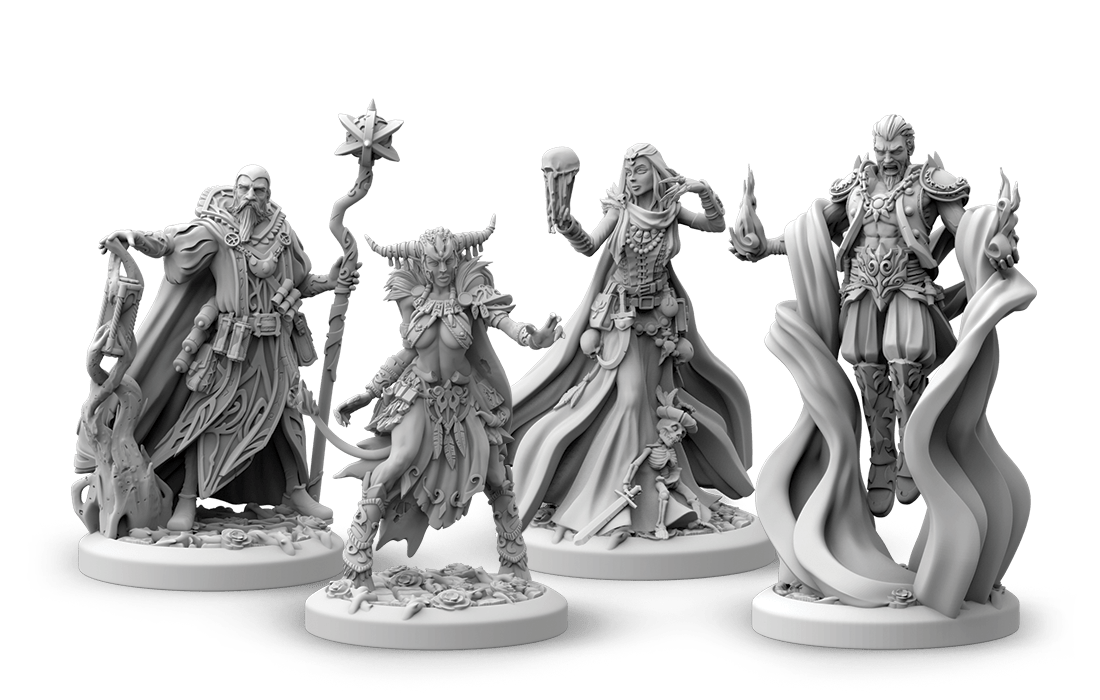Black Rose Wars – First Impressions
Ludus Magnus Studio makes pretty games that I want in my collection. Is it initially because they’re so pretty? Maybe, but I’m not ashamed of my attraction to the shiny.
Yet with Black Rose Wars, my first thought wasn’t, “Oh my, that’s a delicious pile of cardboard and plastic!”
It was more like, “Oh my, I want to blow things (and other people) up with crazy spells!”
It’s like NSFW Harry Potter…
For the uninitiated in the crowd, Black Rose Wars is a conflict-saturated fantasy game full of complex deck-building, intense dormitory wars, and a whole lotta magical instability. Each player takes control of a mage of the Black Rose Order, which is an exclusive club of bolt-tossing, fire-slinging, trap-setting madmen and women bent on becoming the next Supreme Magister. The Black Rose Artifact only bends to the most influential and powerful mage, however.
If you want to be victorious, you’ll need to create an effective Grimoire of spells from the different schools of magic, to impress the Black Rose through the completion of quests, and to mercilessly battle the other mages in an indoor skirmish that makes a food fight look like…. well, a food fight. This is an all-out brawl, dodgeball contest, and popularity contest rolled into one.
Beat back your opponents. Grow your power.
What It Does
Here’s the quick and dirty:
Mages start with seven spells in their grimoire, one unique spell specific to the character, and six spells from a starting set within one school of magic.
Spells are placed on a player board every main turn of Black Rose Wars and the three standard spells at the bottom must be played in left to right order. The fourth spell in the quick spell slot can be used at any time.
Mages will fight outside of their dormitories in the shifting rooms surrounding the Black Rose Artifact.
Dealing damage to other mages, destabilizing the rooms around you, and completing quests under the watchful presence of the Black Rose will all increase your power and prestige.
Summoning evocations, activating rooms, and incorporating new spells into your grimoire are all necessary moves to increase your chances of winning.
Now, at first, that all sounds well and good. But there are a lot of moving parts and mechanical nuances for players to consider that can be a gameplay hurdle for some.
And the first play definitely worried me. Not because of how it affected me, but for how it punished new players. I had read enough rules and watched enough gameplay of the board game to not be intimidated or confused, but it’s a rough experience to onboard all of the information for the game in one sitting.
Here’s how things can overwhelm a new player:
Players start with a grimoire of six cards. But those cards come from one of six decks—Conspiracy, Destruction, Divination, Illusion, Necromancy, and Transmutation. And those six decks represent schools of magic, which have 36 cards and two starting card combinations for players to consider.
Once they have those cards, they will need to figure out which of the two spells they want to activate from each card. Because each card has two…
But they have to play them in order. And intelligently because bringing out that evocation first will likely get it killed before it has a chance to do anything. And you’ll need to consider whether you have line of sight with a spell, if it targets a room or a mage, and if it’s going to damage the room you’re in with instability. Also, make sure you’ve got that protection spell loaded in the right slot or else your mage may die and get sent back to their dormitory.
While you consider all of this, make sure you’re moving toward completing your missions and don’t lag behind the Black Rose Artifact (or the other players) in power.
Each turn will also consist of end-of-turn phases that activate remaining evocations and clear player mats of used spells. Oh, certain milestones in player power might also cause the quest and event decks to immediately shift into the next moon phase. Did I mention there was an event deck? It will definitely affect gameplay on a per-round basis.
Can you see how it might get a little heavy early on?
Now to be clear, I had an absolute blast playing this game.
But it does have some growing pains. It’s got a learning curve. Once you’re past that, though, the game really opens up and players start to dig into the fun.
I knew that things were ramping up when on the second round fo the game a player threw a fireball at an opponent who redirected it an a different adjacent mage, who then slung it back at the active player that started it all in the first place.
It was like an arcane game of hot potato… if the potato was a flaming ball of death.
That’s how I knew that Black Rose Wars was going to be something I wanted in my collection. That singular moment made up for the rough start and more complex rules amalgam.
How It Does It
The player mats showcase the mage, their maximum health, action slots, trophies from killed mages and/or destroyed rooms, as well as the in-hand, active, and discarded spells from a player’s grimoire. This is the command center for all things concerning magical destruction and deflection.
Players will want their spells in the right slots. The standard spells at the bottom must be activated from left to right. The quick spell up top can be activated on any turn. And the action slots to the side allow for physical movements, attacks, and interactions.
Spells are the heart and soul of Black Rose Wars. Figuring out the best combination of offensive spells, sneaky traps, and mitigating protections will help players to avoid being bullied and enforce their arcane will on their opponents.
Each card has two versions of the spell that can be used depending on what’s needed, but it has to be selected prior to revealing it. Quests also provide additional scoring opportunities outside of the brutal combat in which mages engage every turn. Finally, event cards infuse each game with positive or negative influences that players must adapt to. The same events also empower the Black Rose Artifact.
Rooms are where the action happens. The layout of the board will change every game, but each room has a set ability which can be used to summon evocations, heal, complete quests, manipulate other players, allow access to the libraries of the schools of magic, etc. Using these rooms wisely is another key factor in a winning strategy.
Rooms, like mages, though, can be destroyed. When a room has suffered enough instability from the magical overflow of the mages’ spells, it will collapse and no longer be functional other than as a physical space to move in and out of.
Once you understand these core principles, you’re ready for the game!
Why You Might Like It
The sheer number of spells and schools of magic at your disposal mean that you can create some thrilling tactical combinations between the attacks, traps, and protections that you conjure.
The participation-based scoring in combat means that when a mage is knocked out, it’s not one player stealing all of the points. It makes the skirmish experience that much more satisfying when it rewards aggression in an inclusive way.
Why You Might Not
The first play can be a brutal experience for players. It can seem an inscrutable game with unclear processes until you see how it all connects. Needing to build your own deck of spells when you don’t even understand the schools of magic is confusing.
Even once you know the rules, there is a decent amount of setup for the game and it can also feel a tad long in the final phase.
Final Thoughts
I’ve been wanting to play Black Rose Wars for some time. I can’t remember the first time I was exposed to the game, but I immediately thought it looked like something up my alley.
And, ultimately, that anticipation was warranted. The game was engaging, the combat exciting, and the experience fulfilling. The base box alone feels like it has a ton of content to explore, what with the different evocations to summon and the distinct schools of magic with which to experiment.
I think it will definitely be better when playing with the same players who understand how the game functions but I do also like it enough that I’d happily teach it to new players. I’d just be mindful of the best ways to coach them through the first few rounds until they were ready to start anew.
Discovering connections between schools of magic, creating strong one-two punches of traps and offensive spells, and maneuvering around the board to avoid players, attack them, and complete quests all at the same time is an immensely satisfying process.
I want to jump back in and see how it holds up after four or five more plays. I’m leaning toward it holding up and even improving upon my first impressions of the game. If you own the game but haven’t had the opportunity to break it out, you definitely should.
I like the spells. I like the destructive nature of a mage-vs-mage power struggle. And the production quality that Ludus Magnus Studio has brought to this title is exquisite. I really want the game and I’m anxious to try it out more and see whether my initial excitement endures or abates. I suspect the former, so I hope to play again soon!
If you want to check out Black Rose Wars, you can visit Ludus Magnus Studio or read what the community thinks on BoardGameGeek.
Have you played Black Rose Wars? What other skirmish games do you like?
Let us know in the comments and give a recommendation for other games of which to share our first impressions.







